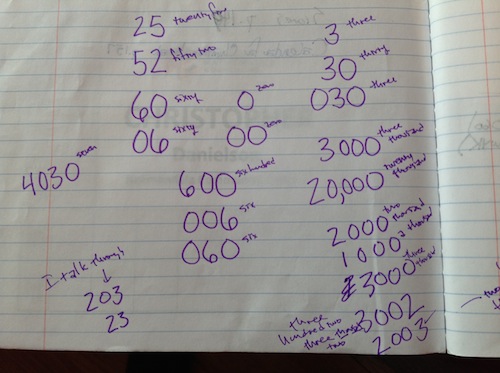In yesterday’s post, I told of the Christmas Countdown cube calendar, and of how Tabitha (6 years old) changed my 06 days to 6 days by removing the leading zero. I challenged readers to consider her reasons for this.
Of course I asked her. I showed her the pictures I took and asked why she had taken off the zero. Here are the results of our conversation.
Me: I’m curious about why you took off the zero.
Tabitha (6 years old): Because there aren’t sixty days until Christmas.
A new piece of research has been making the rounds in the media recently. I will write about it at length soon, but for now you just need to know that the common headline is something like, “Young children know more about place value than most people assume they do.” In particular, the research looked carefully at the partial place value knowledge children have, rather than just calling wrong answers wrong.
Helping children develop partial knowledge into better knowledge through exploring and talking is the heart of the work here at Talking Math with Your Kids. Naturally I want to explore Tabitha’s knowledge here.
I get out a piece of paper, a pen and write some numbers, asking her to tell me what they are. I write down her responses verbatim so that I can share them with you.
25
Twenty-five
52
Fifty-two
A reasonable hypothesis for Tabitha saying that “06” meant “sixty” would be that she doesn’t pay attention to the order of the digits in a number. We now know this isn’t true.
More numbers follow.
60
Sixty
06
Sixty
Now things are getting interesting. There seems to be something special about that zero out front. We do some more.
600
Six hundred
006
Six
What? I was sure she was going to say six hundred for this one.
060
Six
Hmmm….
0
Zero
00
Zero
No hesitation on this one, which surprises me. I thought she might object to two zeroes.
3
Three
30
Thirty
030
Three
At least this one is consistent with 060.
I am beginning to wonder how she will work with numbers that have zeroes in the middle of them, such as 1002. And I am curious how she will work with numbers that use the same words, but in a different order. I think of 1002 and 2001 as a good example: one thousand-two and two thousand-one. So I build up to those.
2000
Two thousand
1000
A thousand
Uh oh. I didn’t expect this. I expected one thousand, not a thousand. I have to change my examples.
3000
Three thousand
3002
Three hundred two…er…three thousand two
2003
Two hundred three
Beautiful! This is what the researchers were saying—children have partial place value knowledge. What is going on here is this: 3002 looks like 300 with a 2 at the end. This is a very common error, and it represents trying to make sense of a complicated idea.
We do only one more; I can tell she is getting tired.
4030
Seven
I cannot tell if she is being silly or serious, trying hard or being clever.
So what do we learn?
Just as with learning to speak a native (or foreign) language, learning about numbers is not an all-or-nothing proposition. Children have partial knowledge that is sometimes inconsistent. Tabitha self-corrected on 3002, but not on 2003. This conversation supports her thinking about the structure of numbers. She will think about it in the future and be more prepared to pay attention to it because we talked about it. When she wants to know more, she will ask.
Starting the conversation
Children learn about numbers and language in similar ways—through exposure in their everyday environments. We read to our children to enrich their language environment, and we can expose our children to numbers to enrich their math environment. Waffles, toys and calendars are all examples of everyday objects with mathematical structure that children can play with.
Have these things available. Ask about how your children play with them. Listen to their answers. Then ask follow up questions.

